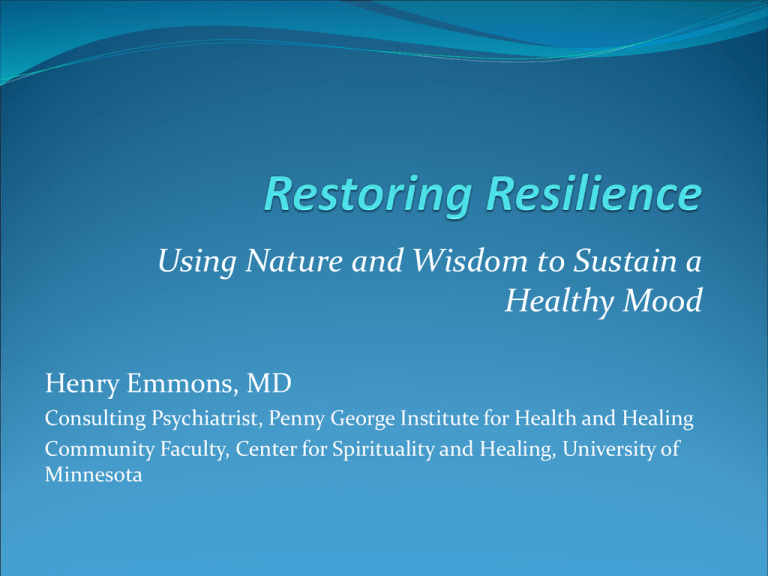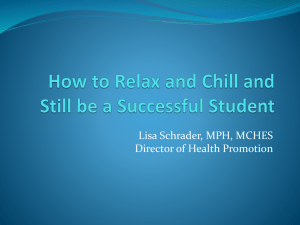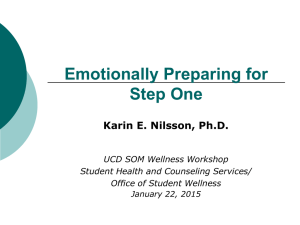Resilience Training
advertisement

Using Nature and Wisdom to Sustain a Healthy Mood Henry Emmons, MD Consulting Psychiatrist, Penny George Institute for Health and Healing Community Faculty, Center for Spirituality and Healing, University of Minnesota Joy “Surely joy is the condition of life.” Thoreau A Holistic Disease? Depression and Anxiety 100 years Increased 10% per decade Seligman 10 times higher risk Disability US WHO Causes of Depression/Anxiety If not just genetics, then… Why? The Enemies of Joy Physical Imbalance and Toxicity The Mind Run Rampant The Illusion of Separation The Science of Hope Neuroplasticity Gene Cell Expression Turnover Neuroplasticity The brain is capable of change. Cell Turnover Cells are programmed to die and be replaced Gene Expression Genes can be turned on or off. Resilience The metaphor of the water cooler The Seven Roots of Resilience BODY Balance Brain Chemistry Manage Energy Align with Nature MIND Calm the Mind Turn Toward Emotions SOUL Cultivate a Good Heart Create Deep Connections The Triad of Health: (Physical Imbalance/Toxicity) Balancing Brain Chemistry: NUTRITION Managing Energy: Aligning with Nature: EXERCISE SLEEP Balancing Brain Chemistry: The Resilient Diet Eating healthier will ALWAYS help you feel better. Calming Foods Complex Carbs Beans and Legumes Root Vegetables Whole Grains Moderate Protein Lean Meats Eggs/Dairy Protein Powders Omega 3’s Fatty fish Nuts and Seeds Eat frequently Always Breakfast Every 3-4 hours Energizing Foods Think summer Lean protein Fewer Carbs High water foods Nutritional Supplements Basic Supplements Multivitamin or B-Complex Take half the dose twice daily Look for minimum 50 mg B6 per day Omega 3 1000 mg Fish Oil twice daily And/or 2 T. ground flaxseed Vitamin D3 2000-5000 IU daily from October through April Probiotic Especially if GI symptoms The Triad of Health: (Physical Imbalance/Toxicity) Balancing Brain Chemistry: NUTRITION Managing Energy: Aligning with Nature: EXERCISE SLEEP Managing Energy: Resilient Movement 1. Non-Exercise 2. Exercise 3. Mindful Movement Managing Energy with “Non-Exercise” Any movement of daily living Burns calories Tones muscles Managing Energy with Exercise: Calming Anxiety Any gentle, rhythmic movement Being in nature is a plus Managing Energy with Exercise: Increasing Energy •More vigorous •Increase heart rate •Break a sweat •Weight training •Interval training Managing Energy with Exercise: How to Increase Anger Exercise Guidelines: Adults Weekly minimum exercise: At least 2 ½ hours of moderate-intensity aerobic activity per week OR 75 minutes of vigorous-intensity aerobic activity per week PLUS muscle-strengthening activity on at least 2 days per week Source: http://www.cdc.gov/physicalactivity/everyone/guideli nes/adults.html Exercise Guidelines: Children At least 1 hour or more per day Mostly aerobic Should be vigorous at least 3 times per week Include muscle strengthening (e.g. push-ups or gymnastics) at least 3 days per week as part of the 60 minutes Include bone-strengthening activities, like jumping rope or running, at least 3 times per week. Mindful Movement/Yoga Mindful Movement/T’ai Chi Mindful Movement/Walking The Triad of Health: (Physical Imbalance/Toxicity) Balancing Brain Chemistry: NUTRITION Managing Energy: Aligning with Nature: EXERCISE SLEEP Resilient Sleep Sleep problems are a common trigger for mental illness There is no way to recover fully unless sleep improves Natural Sleep: How much? Average in 1900 Average today Timing Naps Natural Sleep: What hurts? Natural Sleep: What hurts? Natural Sleep: What hurts? Natural Sleep: What Helps? Natural Sleep: What Helps? The Enemies of Joy Physical Imbalance and Toxicity The Mind Run Rampant The Illusion of Separation Mindfulness Awareness Moment to moment Intentional Non-Judging Slowing and Acceptance down, honoring the rhythms of nature Observing the mind from a ring-side seat The Psychology of Mindfulness Mindfulness (Vipassana) (The Mind Run Rampant) Heartfulness (Metta) (The Illusion of Separation) The practice of seeing and The practice of learning to accepting things as they really are Learning to do less harm love well Cultivating a larger self Life Includes Suffering The Origin of Suffering is Attachment The End of Suffering is Attainable There Is a Path to the End of Suffering Resilience is your nature Adventitious Suffering The Second Arrow Favorite Flavors of Reaction Reactivity Emotion Grasping Fear Aversion Anger Denial Flat/Dull Impermanence Let everything happen to you: beauty and terror. Just keep going. No feeling Is final. -Rilke Emotional Steadiness Grounding Non-Attachment Opportunities for Mindfulness Self-Aversion “I am now the most miserable man living.” -Abraham Lincoln January 1, 1841 Cultivating a Good Heart Reactivity Antidotes Grasping Generosity Aversion Compassion Denial Awareness What does everyone want? We can live without religion and meditation, but we cannot survive without human affection. -The Dalai Lama Encountering Soul "This is the first, wildest, and wisest thing I know, that the soul exists, and that it is built entirely out of attention.“ -Mary Oliver Returning to Your True Home It is not perfection that we seek. It is fuller growth into who we truly are. It is to live, as fully and joyfully as we can, each moment capable of giving and receiving, loving and being loved, caring and being cared for, healing and being healed.






